Index
Page 3 of 5
Obsidian 800D is 609mm tall so “full tower” classification is spot on. Although the design is mostly classic with sharp and flat edges, the brushed aluminum on the front panel and matter side-panels prove that it’s a quality piece of metal. Elevated feet further reinforce the impression of stability and sturdiness.
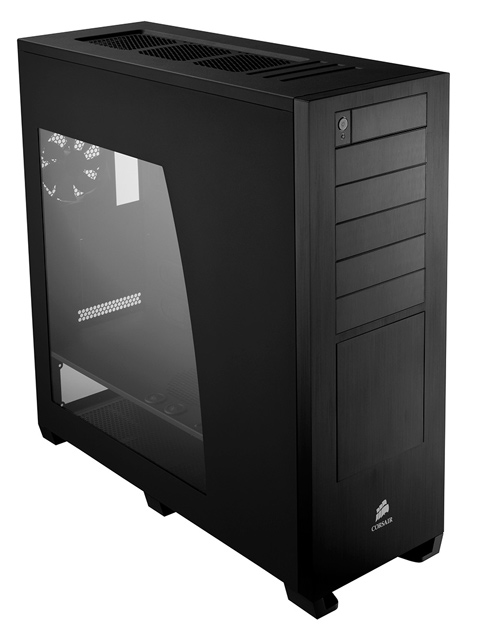
The case is 226mm wide and 609mm long. Of course, just looking at the Obsidian 800D won’t reveal much, but all things taken into account will reveal the reason why the price is over €230.
As you can see from the photo above, Obsidian 800D features a large window on the left side-panel, and you can see that innards are split into two chambers. You can also see the back-panel fan, which is one of 7 possible fans in Obsidian 800D.
It seems Corsair went all out on the front panel as it’s naturally the prettiest side of the case, mostly for the fact that it’s made of brushed aluminum. Power button is located towards the top of the case and except for the small LED, there’re no other visible buttons or connectors. Almost all the connectors you’ll need are hidden behind the few doors. As you can see from the picture of the front panel, Obsidian 800D allows for 5 optical devices and mounting them requires the front panel to be taken off. Thankfully, that’s a piece of cake and all you need to do is tug on the lower side of the front panel without having to remove screws on the inside (we’ll talk about this more later).
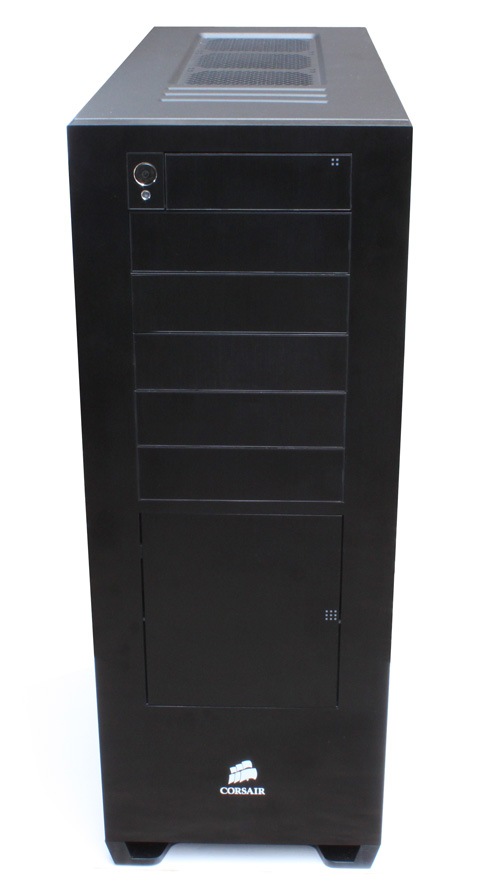
5.25 bay covers are made of aluminum-coated plastic, although we’ve noticed that one lid already started to give way and the aluminum coating started detaching, but it might be an isolated case. Of course, we didn’t mind much (as long as it’s on one cover only) because we removed the cover anyway and mounted an optical drive.
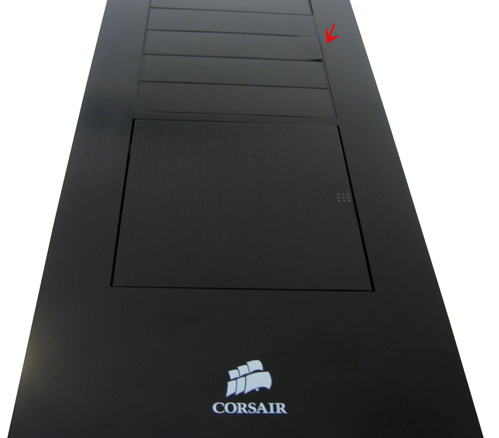
Corsair decided against positioning the USB connector panel on top of the case, although we’d have liked it to be on top for better accessibility. The USB panel is located behind the door on the front panel (towards the top, next to the power button). Of course, many users will find this to be practical as well, and we must admit that we’d have nothing against it if it featured an eSATA connector that’s found on many much cheaper cases.

Apart from the four USB connectors there’s also FireWire, audio in/out connector and the reset key. The door is opened by pushing it, just like the larger one hiding the hotSwap HD bays. You can mount up to four 3.5’’ SATA hard disks there.
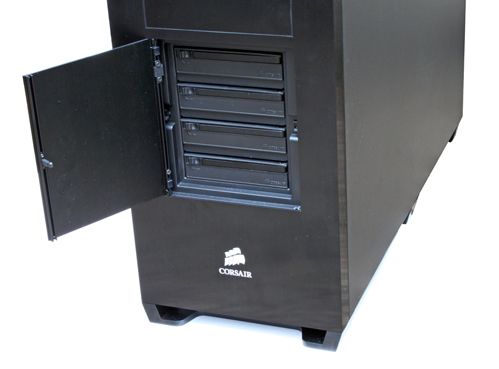
HotSwap HD bays are extremely practical, especially for those who swap their HDs often. If you take a closer look at the following picture, you’ll notice two holes on the lower side and they’re intended for mounting 2.5’’ SSDs. This is a pretty practical solution which requires no additional brackets.
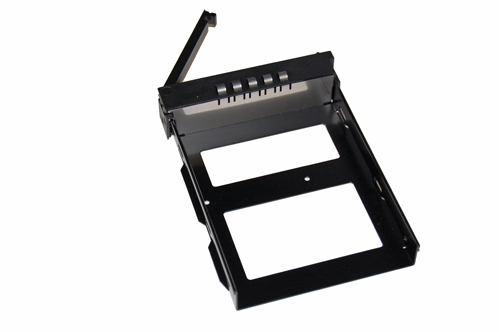
There’s no need to open up the case and connect power and data cables – all you need to do is place the hard disk into the bracket and slide it back, whereas the hotSwap mechanism will make sure that the disk starts running instantly. Removing the door and changing the direction they open is a piece of cake and it only takes a couple of seconds.
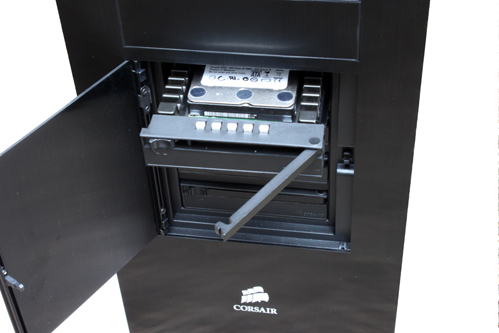
The only thing showing that this case is Corsair’s is a small and pretty discrete Corsair logo on the bottom of the front panel. The difference between the builds of front and side panels is evident due to different material being used. Side panels are pretty large and as we’ve already mentioned, the left side features a window whereas the right side is pretty uninteresting.
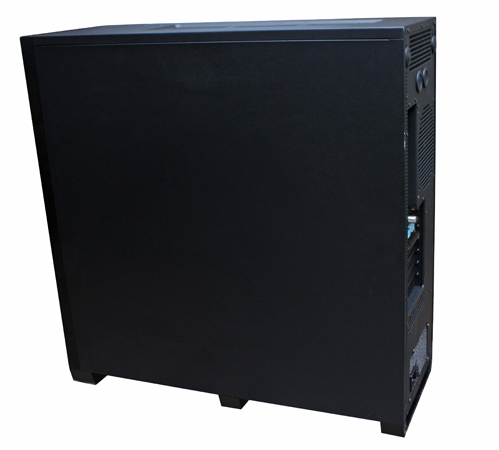
Taking off and mounting the side-panels is similar to CoolerMaster’s Cosmos case – the best method we’ve seen so far. Two buttons on the top-rear side of the case are used to unfasten the panels which can then easily be removed. No screws are used to hold the sides in place.
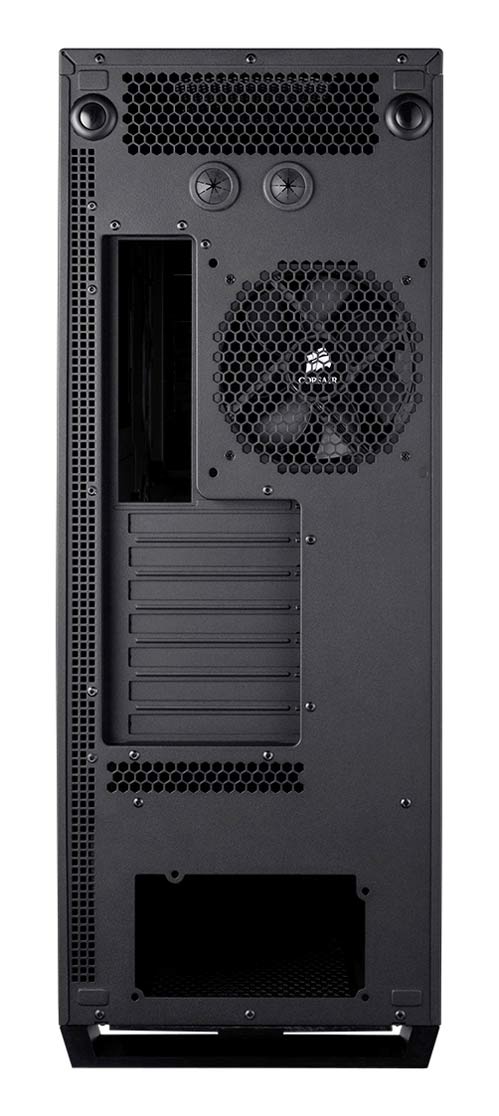
The rear side as usual features a fan and there’s place for 7 motherboard expansion slots. You can easily replace the preinstalled 140mm fan with a 120mm one, and the mounting holes are provided (the picture shows the 120mm fan mounted, but the case comes with a 140mm one).
As the picture shows, the PSU is located on the bottom with the fan blowing downwards. Corsair uses a large air-filter below the PSU, and it’s accessible without the need to open the case. The filter is an excellent solution to dust that gathers during time, and the filter is of course much easier to clean.
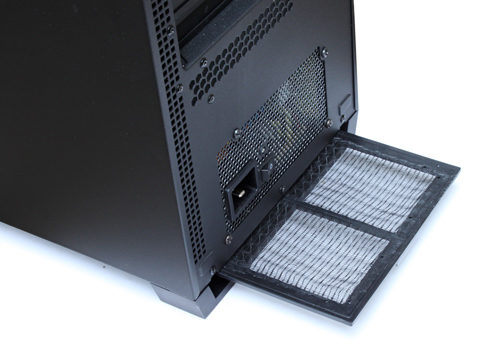
The holes on the left side (the picture above shows them as a vertical array of holes) are proof that Corsair thought of cable management and left space for cables to be routed behind the motherboard and hide them from sight. Furthermore, Corsair thought of airflow at the same time because messy and numerous cables often hinder airflow thus introducing higher thermals on virtually all components in the case.
The following picture shows the plastic mesh filter, which is long enough to filter incoming air as well.
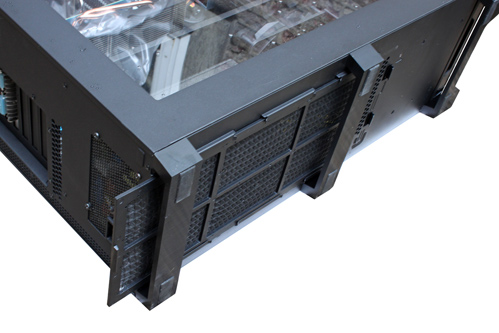
Obsidian 800D’s feet are massive and stable. Since the front panel features no air outlets, there’s plenty of room between the floor and the case to provide adequate fresh air inflow from the bottom.
The following picture shows the rear-panel after mounting MSI’s P45D3 Platinum motherboard, Gigabyte 9800GT passively cooled graphics card and CoolerMaster’s 1100W Ultimate PSU.
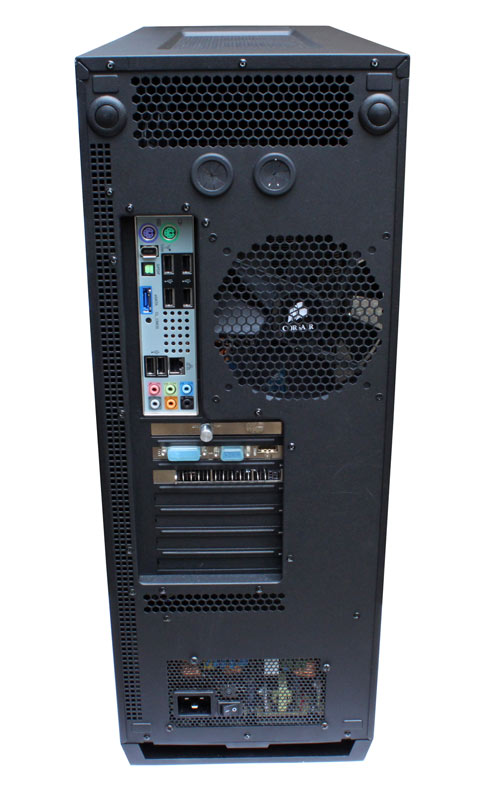
The largest air intake on Obsidian 800D is on the top panel. There’s enough room for mounting three 1200m fans and/or watercooling radiator, which Corsair anticipated and left holes for just such scenarios.
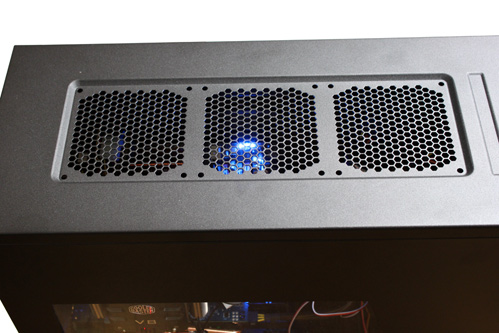
Since Obsidian 800D’s top panel doesn’t come with pre-mounted fans, the wide holes are used as passive air outlets. Although the sides do well in absorbing sounds coming from within, noise indeed escapes via these outlets. Obsidian 800D does require serious airflow for optimum operation in less than optimum environments, but Corsair could’ve gone with finer, mesh grills on the top panel which would at least look better.
The three pre-installed fans in the Obsidian 800D are pretty quiet, but not inaudibly. Compared to similar cases however, Obsidian 800D belongs to the quieter pack and you won’t hear it in your living room.
